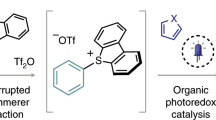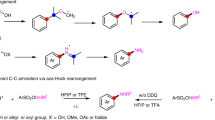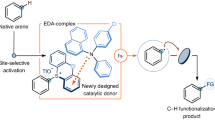Abstract
Alkylamines have a range of applications including as reagents in organic synthesis and as bioactive compounds in medicinal chemistry. Methods for the synthesis of alkylamines, however, typically suffer from low availability or inaccessibility of key reaction components and uncontrollable selectivity. While photocatalytic two-component reactions have become versatile strategies for the synthesis of alkylamines, multicomponent variants remain underdeveloped. Here we describe a metallaphotoredox-promoted three-component amination reaction using tertiary alkylamines, nitroarenes and carboxylic acids to give N-alkyl aniline products. The utility of this three-component approach is highlighted through the availability and broad scope of the reaction substrates and the application to the expedited synthesis of drug molecules and intermediates. Mechanistic investigations reveal this chemo- and regioselective transformation probably proceeds through a formal amine group transposition and C–H alkylation of a tertiary alkylamine substrate.

This is a preview of subscription content, access via your institution
Access options
Subscribe to this journal
Receive 12 digital issues and online access to articles
$119.00 per year
only $9.92 per issue
Buy this article
- Purchase on Springer Link
- Instant access to full article PDF
Prices may be subject to local taxes which are calculated during checkout





Similar content being viewed by others
Data availability
The experimental and analytical procedures and full spectral data are available in the supplementary materials. Crystallographic data for the structures reported in this Article have been deposited at the Cambridge Crystallographic Data Centre, under deposition numbers CCDC 2209594 (59) and 2247663 (86).
References
Ricci, A. & Bernardi, L. Methodologies in Amine Synthesis: Challenges and Applications (Wiley, 2021).
Roughley, S. D. & Jordan, A. M. The medicinal chemist’s toolbox: an analysis of reactions used in the pursuit of drug candidates. J. Med. Chem. 54, 3451–3479 (2011).
Blakemore, D. C. et al. Organic synthesis provides opportunities to transform drug discovery. Nat. Chem. 10, 383–394 (2018).
Talele, T. T. Opportunities for tapping into three-dimensional chemical space through a quaternary carbon. J. Med. Chem. 63, 13291–13315 (2020).
Lovering, F., Bikker, J. & Humblet, C. Escape from flatland: increasing saturation as an approach to improving clinical success. J. Med. Chem. 52, 6752–6756 (2009).
Barreiro, E. J., Kümmerle, A. E. & Fraga, C. A. M. The methylation effect in medicinal chemistry. Chem. Rev. 111, 5215–5246 (2011).
Schönherr, H. & Cernak, T. Profound methyl effects in drug discovery and a call for new C–H methylation reactions. Angew. Chem. Int. Ed. 52, 12256–12267 (2013).
Afanasyev, O. I., Kuchuk, E., Usanov, D. L. & Chusov, D. Reductive amination in the synthesis of pharmaceuticals. Chem. Rev. 119, 11857–11911 (2019).
Monnier, F. & Taillefer, M. Catalytic C–C, C–N, and C–O Ullmann-type coupling reactions. Angew. Chem. Int. Ed. 48, 6954–6971 (2009).
Ruiz-Castillo, P. & Buchwald, S. L. Applications of palladium-catalyzed C−N cross-coupling reactions. Chem. Rev. 116, 12564–12649 (2016).
Nakamura, Y. et al. Design and optimization of novel (2S,4S,5S)-5-amino-6-(2,2-dimethyl-5-oxo-4-phenylpiperazin-1-yl)-4-hydroxy-2-isopropylhexanamides as renin inhibitors. Bioorg. Med. Chem. Lett. 22, 4561–4566 (2012).
Trowbridge, A., Walton, S. M. & Gaunt, M. J. New strategies for the transition-metal catalyzed synthesis of aliphatic amines. Chem. Rev. 120, 2613–2692 (2020).
He, C., Whitehurst, W. G. & Gaunt, M. J. Palladium-catalyzed C(sp3)–H bond functionalization of aliphatic amines. Chem 5, 1031–1058 (2019).
Huang, L., Arndt, M., Gooßen, K., Heydt, H. & Gooßen, L. J. Late transition metal-catalyzed hydroamination and hydroamidation. Chem. Rev. 115, 2596–2697 (2015).
Liu, R. Y. & Buchwald, S. L. CuH-catalyzed olefin functionalization: from hydroamination to carbonyl addition. Acc. Chem. Res. 53, 1229–1243 (2020).
Murray, P. R. D. et al. Photochemical and electrochemical applications of proton-coupled electron transfer in organic synthesis. Chem. Rev. 122, 2017–2291 (2022).
Holmberg-Douglas, N. & Nicewicz, D. A. Photoredox-catalyzed C−H functionalization reactions. Chem. Rev. 122, 1925–2016 (2022).
Leitch, J. A., Rossolini, T., Rogova, T., Maitland, J. A. P. & Dixon, D. J. α‑Amino radicals via photocatalytic single-electron reduction of imine derivatives. ACS Catal. 10, 2009–2025 (2020).
Garrido-Castro, A. F., Maestro, M. C. & Alemán, J. α-Functionalization of imines via visible light photoredox catalysis. Catalysts 10, 562 (2020).
Kwon, K., Simons, R. T., Nandakumar, M. & Roizen, J. L. Strategies to generate nitrogen-centered radicals that may rely on photoredox catalysis: development in reaction methodology and applications in organic synthesis. Chem. Rev. 122, 2353–2428 (2022).
Pratley, C., Fenner, S. & Murphy, J. A. Nitrogen-centered radicals in functionalization of sp2 systems: generation, reactivity, and applications in synthesis. Chem. Rev. 122, 8181–8260 (2022).
Rivas, M., Palchykov, V., Jia, X. & Gevorgyan, V. Recent advances in visible light induced C(sp3)–N bond formation. Nat. Rev. Chem. 6, 544–561 (2022).
Trowbridge, A., Reich, D. & Gaunt, M. J. Multicomponent synthesis of tertiary alkylamines by photocatalytic olefin-hydroaminoalkylation. Nature 561, 522–527 (2018).
Kumar, R., Flodén, N. J., Whitehurst, W. G. & Gaunt, M. J. A general carbonyl alkylative amination for tertiary amine synthesis. Nature 581, 415–420 (2020).
Jiang, H., Seidler, G. & Studer, A. Carboamination of unactivated alkenes through three-component radical conjugate addition. Angew. Chem. Int. Ed. 131, 16680–16684 (2019).
Gui, J. et al. Practical olefin hydroamination with nitroarenes. Science 348, 886–891 (2015).
Nappi, M., Hofer, A., Balasubramanian, S. & Gaunt, M. J. Selective chemical functionalization at N6-methyladenosine residues in DNA enabled by visible-light-mediated photoredox catalysis. J. Am. Chem. Soc. 142, 21484–21492 (2020).
Ouyang, K., Hao, W., Zhang, W.-X. & Xi, Z. Transition-metal-catalyzed cleavage of C–N single bonds. Chem. Rev. 115, 12045–12090 (2015).
Wang, Q., Su, Y., Li, L. & Huang, H. Transition-metal catalysed C–N bond activation. Chem. Soc. Rev. 45, 1257–1272 (2016).
Chen, C., Liu, W., Liu, B., Zhou, P. & Tan, H. Acylation of arylamines with triethylamine derivatives in combination with tert-butyl hydroperoxide. Asian J. Org. Chem. 8, 470–474 (2019).
Gao, Q. et al. Deaminative cyclization of tertiary amines for the synthesis of 2‑arylquinoline derivatives with a nonsubstituted vinylene fragment. Org. Lett. 25, 109–114 (2023).
Thullen, S. M. & Rovis, T. A mild hydroaminoalkylation of conjugated dienes using a unified cobalt and photoredox catalytic system. J. Am. Chem. Soc. 139, 15504–15508 (2017).
Shen, Y., Funez-Ardoiz, I., Schoenebeck, F. & Rovis, T. Site-selective α‑C−H functionalization of trialkylamines via reversible hydrogen atom transfer catalysis. J. Am. Chem. Soc. 143, 18952–18959 (2021).
Shen, Y. & Rovis, T. Late-stage N‑Me selective arylation of trialkylamines enabled by Ni/photoredox dual catalysis. J. Am. Chem. Soc. 143, 16364–16369 (2021).
Mao, R., Frey, A., Balon, J. & Hu, X. Decarboxylative C(sp3)–N cross-coupling via synergetic photoredox and copper catalysis. Nat. Catal. 1, 120–126 (2018).
Mao, R., Balon, J. & Hu, X. Cross-coupling of alkyl redox-active esters with benzophenone imines: tandem photoredox and copper catalysis. Angew. Chem. Int. Ed. 57, 9501–9504 (2018).
Wang, S. et al. Decarboxylative tandem C–N coupling with nitroarenes via SH2 mechanism. Nat. Commun. 13, 2432 (2022).
Chan, A. Y. et al. Metallaphotoredox: the merger of photoredox and transition metal catalysis. Chem. Rev. 122, 1485–1542 (2022).
Zuo, Z. et al. Merging photoredox with nickel catalysis: coupling of α-carboxyl sp3-carbons with aryl halides. Science 345, 437–440 (2014).
Yang, Y.-F., Lin, J.-H. & Xiao, J.-C. Starting from styrene: a unified protocol for hydrotrifluoromethylation of diversified alkenes. Org. Lett. 23, 9277–9282 (2021).
Wang, B., Zhou, M.-J. & Zhou, Q.-L. Visible-light-induced α,γ-C(sp3)–H difunctionalization of piperidines. Org. Lett. 24, 2894–2898 (2022).
Yi, M.-J. et al. Organic photoredox catalytic α-C(sp3)–H phosphorylation of saturated aza-heterocycles. Chem. Commun. 57, 13158–13161 (2021).
Maldotti, A. et al. Photochemical and photocatalytic reduction of nitrobenzene in the presence of cyclohexene. J. Photochem. Photobiol. A 133, 129–133 (2000).
Beatty, J. W. & Stephenson, C. R. J. Amine functionalization via oxidative photoredox catalysis: methodology development and complex molecule synthesis. Acc. Chem. Res. 48, 1474–1484 (2015).
Zhang, J.-J., Yang, J.-C., Guo, L.-N. & Duan, X.-H. Visible-light-mediated dual decarboxylative coupling of redox-active esters with α,β-unsaturated carboxylic acids. Chem. Eur. J. 23, 10259–10263 (2017).
Xiao, J., He, Y., Ye, F. & Zhu, S. Remote sp3 C–H amination of alkenes with nitroarenes. Chem 4, 1645–1657 (2018).
Norambuena, E., Olea-Azar, C., Rufs, A. M. & Encinas, M. V. Photoreduction of 4-substituted nitrobenzenes by amines. Phys. Chem. Chem. Phys. 6, 1230–1235 (2004).
Chandrashekhar, V. G., Baumann, W., Beller, M. & Jagadeesh, R. V. Nickel-catalyzed hydrogenative coupling of nitriles and amines for general amine synthesis. Science 376, 1433–1441 (2022).
Miyabe, H., Yoshioka, E. & Kohtani, S. Progress in intermolecular carbon radical addition to imine derivatives. Curr. Org. Chem. 14, 1254–1264 (2010).
Zhao, X. et al. Divergent aminocarbonylations of alkynes enabled by photoredox/nickel dual catalysis. Angew. Chem. Int. Ed. 60, 26511–26517 (2021).
Jia, J., Lefebvre, Q. & Rueping, M. Reductive coupling of imines with redox-active esters by visible light photoredox organocatalysis. Org. Chem. Front. 7, 602–608 (2020).
Lv, X.-Y., Abrams, R. & Martin, R. Dihydroquinazolinones as adaptative C(sp3) handles in arylations and alkylations via dual catalytic C–C bond-functionalization. Nat. Commun. 13, 2394 (2022).
Lucet, D., Le Gall, T. & Mioskowski, C. The chemistry of vicinal diamines. Angew. Chem. Int. Ed. 37, 2580–2627 (1998).
Jin, C., Decker, A. M., Harris, D. L. & Blough, B. E. Effect of substitution on the aniline moiety of the GPR88 agonist 2‑PCCA: synthesis, structure–activity relationships, and molecular modeling studies. ACS Chem. Neurosci. 7, 1418–1432 (2016).
Leiva, R. et al. Aniline-based inhibitors of influenza H1N1 virus acting on hemagglutinin-mediated fusion. J. Med. Chem. 61, 98–118 (2018).
Vashishtha, A. & Vashishtha, M. Naphthylalkylamines and their compositions and methods of regulating cancer related disorders and diseases. PCT Int. Appl. WO 2017070052 (2017).
Blaser, H.-U. A golden boost to an old reaction. Science 313, 312–313 (2006).
Su, Y.-L. & Doyle, M. P. Application of α-aminoalkyl radicals as reaction activators. Synthesis 54, 545–554 (2022).
Acknowledgements
We thank the National Natural Science Foundation of China (nos. 21971186 (C.W.C.), 22271216 (C.W.C.) and 21961142015 (J.-A.M.)), the National Key Research and Development Program of China (no. 2019YFA0905100, J.-A.M.) and the Tianjin Municipal Science & Technology Commission (20JCYBJ00900, C.W.C.) for financial support. We thank the research group of Y.-L. Lei (Tianjin University) for assistance in conducting the UV–vis spectroscopic analysis.
Author information
Authors and Affiliations
Contributions
Z.-W.Z. and C.W.C. discovered the reactions. Z.-W.Z. performed the reaction optimizations and studied the reaction scope and synthetic utility. Z.-W.Z. and Z.F. studied the reaction mechanisms. C.W.C. wrote the manuscript with help from Z.-W.Z., Z.F. and J.-A.M. C.W.C. and J.-A.M. initiated the project, designed the experiments and directed the research.
Corresponding authors
Ethics declarations
Competing interests
The authors declare no competing interests.
Peer review
Peer review information
Nature Synthesis thanks Nicholas Chiappini, Leifeng Wang and the other, anonymous, reviewer(s) for their contribution to the peer review of this work. Primary Handling Editor: Thomas West, in collaboration with the Nature Synthesis team.
Additional information
Publisher’s note Springer Nature remains neutral with regard to jurisdictional claims in published maps and institutional affiliations.
Supplementary information
Supplementary Information
Supplementary Figs. 1–28 and Table 1.
Supplementary Data 1
Crystallographic data for 59 (CCDC 2209594).
Supplementary Data 2
Crystallographic data for 86 (CCDC 2247663).
Rights and permissions
Springer Nature or its licensor (e.g. a society or other partner) holds exclusive rights to this article under a publishing agreement with the author(s) or other rightsholder(s); author self-archiving of the accepted manuscript version of this article is solely governed by the terms of such publishing agreement and applicable law.
About this article
Cite this article
Zhang, ZW., Feng, Z., Ma, JA. et al. Metallaphotocatalytic synthesis of anilines through tandem C–N transposition and C–H alkylation of alkylamines. Nat. Synth 2, 1171–1183 (2023). https://doi.org/10.1038/s44160-023-00370-y
Received:
Accepted:
Published:
Issue Date:
DOI: https://doi.org/10.1038/s44160-023-00370-y
This article is cited by
-
Nickel and light combine for amine synthesis
Nature Synthesis (2023)



